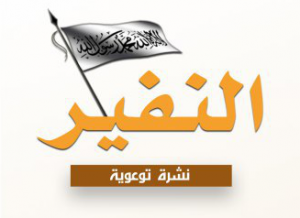As Sahab, the propaganda arm for al Qaeda’s senior leadership, released the latest issue of the group’s Al-Nafir Bulletin yesterday (Mar. 23). And once again al Qaeda was forced to addressed the factional infighting in Syria.

The “disputes and the infighting between factions in Northern Syria” only serve to “support” Bashar al Assad’s “regime and its allies,” Al-Nafir’s editors write. One dispute has followed another, with competing “new fatwas” contributing to the disagreements.
The “spilling” of “the blood of Muslims” is “evil,” Al-Nafir’s authors warn, especially as “the enemy surrounds us from all sides” and is lying in wait to “ambush” the mujahideen “at all times.” Therefore, al Qaeda calls “upon all to stop the infighting and to implement [the] Shariah of Allah and hold fast to the rope of Allah.” Al-Nafir’s writers also advise “all the brothers who have not participated in that fighting to be steadfast upon your position.”
Al Qaeda has been forced to weigh in on the disputes between various factions in Syria a number of times over the last year.
In July 2016, Al Nusrah Front, an official arm of al Qaeda, was rebranded as Jabhat Fath al-Sham (JFS). Months later, in Jan. 2017, JFS merged with several other groups to form Hay’at Tahrir al Sham (HTS). These moves were intended to unify the jihadists’ ranks, creating one political and military entity capable of surviving the nasty, multi-sided war that has ripped Syrian society apart for years. Instead of uniting the various groups, however, the jihadists and Islamists in northern Syria have continued to skirmish. Some accuse HTS’s leader Abu Muhammad al-Julani and his men of seeking to consolidate power in Idlib province as part of their own personal fiefdom.
Some of the infighting has pitted HTS against its longtime, extremist allies. In February, the Nur al-Din al-Zanki Movement and Ahrar al-Sham formed a joint venture known Jabhat Tahrir al-Suriya (JTS), or the Syrian Liberation Front. That new formation has repeatedly clashed with HTS.
Most recently, the Syrian Liberation Front issued a statement on Mar. 22 accusing HTS of launching “attacks [in] the areas of the western Aleppo countryside” using “heavy weapons” and other components of its arsenal. Tellingly, the group referred to HTS as Julani’s “gang” — emphasizing that Julani and his men are the aggressors.
Zanki was a founding member of HTS in Jan. 2017. And parts of Ahrar al-Sham, including its former overall leader, Abu Jaber (also known as Hashem al Sheikh), initially joined HTS as well. Abu Jaber even served as the organization’s first front man. However, not all of Ahrar’s members joined Julani’s project and the group has been reconstituted. Now fighting under the banner of the Syrian Liberation Front, the two organizations called upon HTS to form a common “operations room” for battling the Assad regime, as opposed to each other. Still, their disagreements remain unresolved.
HTS has faced one jihadi controversy after another since its founding. On Oct. 1, 2017, HTS announced that Abu Jaber had been replaced by Julani as its chief, confirming that Julani remained the most powerful figure within the enterprise.
Weeks earlier, in Sept. 2017, Sheikh Abdullah al-Muhaysini announced his resignation from HTS. Muhaysini, a Saudi ideologue and US-designated terrorist, complained about the infighting between HTS and Ahrar. He also cited leaked audio recordings showing that some within HTS’s ranks had it out for him.
Muhaysini’s defection was telling for other reasons. He has been promoted internationally in both al Qaeda’s and the Taliban’s literature. FDD’s Long War Journal assesses that Muhaysini is not a truly “independent” actor, as he claims, but instead serves as a senior al Qaeda-linked cleric. Muhaysini’s decision to leave HTS meant, therefore, that Julani’s project lost a well-connected power broker within jihadi circles.
Earlier this month, Muhaysini announced that he had formed another faction that would abstain from the insurgents’ infighting. It is possible that Al Qaeda had this and similar initiatives in mind when Al-Nafir’s authors praised “the brothers who have not participated in” the conflicts.
Adding to HTS’s problems, other high-profile al Qaeda figures have rejected Julani’s endeavor. Several jihadist units formed yet another military outfit, “Guardians of the Religion” organization, in early March. Abu Hammam al-Shami, an al Qaeda veteran, reportedly leads the group. Abu Hammam, a former military commander and trainer in Al Nusrah Front, has rejected Julani’s moves since mid-2016. Other al Qaeda ideologues and operatives, such as Dr. Sami al-Uraydi and Iyad Nazmi Salih Khalil (also known as Iyad al Tubasi and Abu Julaybib), have denounced Julani as well. Both al-Uraydi and Khalil were briefly imprisoned by HTS last year, adding to the dissent. This led to a reconciliation initiative involving veteran jihadis, who negotiated the pair’s freedom.
The latest edition of Al-Nafir is not the first time al Qaeda has been forced to address the aforementioned disputes in Syria. Previous editions of the news bulletin and other al Qaeda statements have attempted to quell the conflicts as well. Ayman al Zawahiri has also discussed the many problems facing the Syrian jihad, including the ongoing leadership crisis, multiple times over the past year. But as the latest Al-Nafir makes clear, these disputes have not been resolved.








2 Comments
Muslim infighting – love it!
The report was too informative and correct.